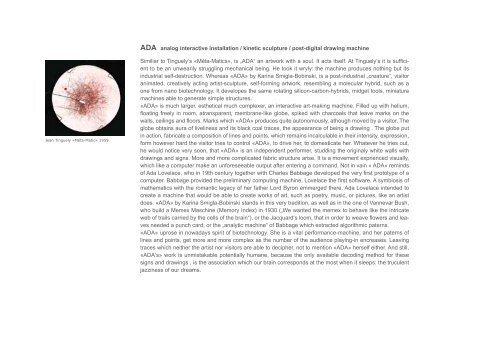Karina Smigla-Bobinski
Karina Smigla-Bobinski
Karina Smigla-Bobinski
You also want an ePaper? Increase the reach of your titles
YUMPU automatically turns print PDFs into web optimized ePapers that Google loves.
ADA analog interactive installation / kinetic sculpture / post-digital drawing machine<br />
Jean Tinguely «Méta-Matic» 1959<br />
Similiar to Tinguely‘s «Méta-Matics», is „ADA“ an artwork with a soul. It acts itself. At Tinguely‘s it is sufficient<br />
to be an unwearily struggling mechanical being. He took it wryly: the machine produces nothing but its<br />
industrial self-destruction. Whereas «ADA» by <strong>Karina</strong> <strong>Smigla</strong>-<strong>Bobinski</strong>, is a post-industrial „creature“, visitor<br />
animated, creatively acting artist-sculpture, self-forming artwork, resembling a molecular hybrid, such as a<br />
one from nano biotechnology. It developes the same rotating silicon-carbon-hybrids, midget tools, miniature<br />
machines able to generate simple structures.<br />
«ADA» is much larger, esthetical much complexer, an interactive art-making machine. Filled up with helium,<br />
floating freely in room, atransparent, membrane-like globe, spiked with charcoals that leave marks on the<br />
walls, ceilings and floors. Marks which «ADA» produces quite autonomously, athough moved by a visitor. The<br />
globe obtains aura of liveliness and its black coal traces, the appearance of being a drawing . The globe put<br />
in action, fabricate a composition of lines and points, which remains incalculable in their intensity, expression,<br />
form however hard the visitor tries to control «ADA», to drive her, to domesticate her. Whatever he tries out,<br />
he would notice very soon, that «ADA» is an independent performer, studding the originaly white walls with<br />
drawings and signs. More and more complicated fabric structure arise. It is a movement exprienced visually,<br />
which like a computer make an unforeseeable output after entering a command. Not in vain « ADA» reminds<br />
of Ada Lovelace, who in 19th century together with Charles Babbage developed the very first prototype of a<br />
computer. Babbage provided the preliminary computing machine, Lovelace the first software. A symbiosis of<br />
mathematics with the romantic legacy of her father Lord Byron emmerged there. Ada Lovelace intended to<br />
create a machine that would be able to create works of art, such as poetry, music, or pictures, like an artist<br />
does. «ADA» by <strong>Karina</strong> <strong>Smigla</strong>-<strong>Bobinski</strong> stands in this very tradition, as well as in the one of Vannevar Bush,<br />
who build a Memex Maschine (Memory Index) in 1930 („We wanted the memex to behave like the intricate<br />
web of trails carried by the cells of the brain“), or the Jacquard‘s loom, that in order to weave flowers and leaves<br />
needed a punch card; or the „analytic machine“ of Babbage which extracted algorithmic paterns.<br />
«ADA» uprose in nowadays spirit of biotechnology. She is a vital performance-machine, and her paterns of<br />
lines and points, get more and more complex as the number of the audience playing-in encreases. Leaving<br />
traces which neither the artist nor visitors are able to decipher, not to mention «ADA» herself either. And still,<br />
«ADA‘s» work is unmistakable potentially humane, because the only available decoding method for these<br />
signs and drawings , is the association which our brain corresponds at the most when it sleeps: the truculent<br />
jazziness of our dreams.


